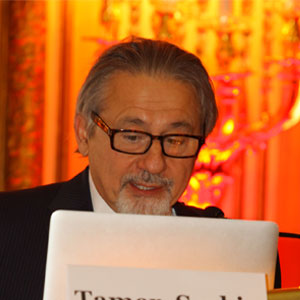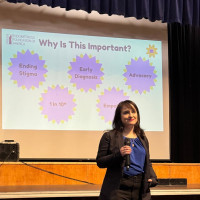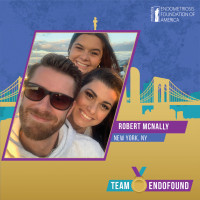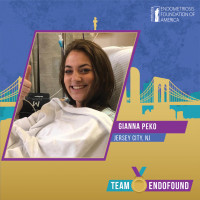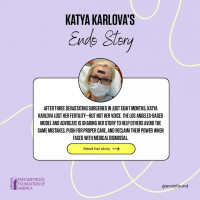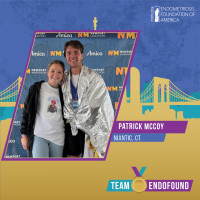Endometriosis Foundation of America 2014
Mission Impossible? - Tamer Seckin, MD
Good morning everyone, this is another day in history making, in my view at least. I am so thankful that you are all here today; many of you came from a far away distance and some of you are local. But I am upbeat, excited and I am confident that this is going to be a great meeting. The topics that we are going to cover and the speakers who are going to talk will be remembered a long time. I think this is going to make history.
The topic of my session besides welcoming you, is introducing you to the Foundation, it was supposed to be Mission Possible. Somehow, whoever did the editing thought it was wrong so they made it impossible! Even though I noticed it I let it go. But, to show you I am optimistic it is actually Mission Possible. I will show you why.
We did see a reason that there was a need for awareness, education, research, early diagnosis, and effective treatment. We made the move five and a half years ago thanks to my patients who supported me initially and because of them I was able to do that. They are the founding board members of my Foundation. Then we have Padma's help. I do not think we would be where we are as far as recognition and everything if she did not allow her pretty face to front this glorious disease that very few admit they have.
We started, obviously, the first meeting with honoring Harry because through my association with him he was my mentor like many doctors throughout the world. It is my association with him that gave me the courage to move forward.
The second year we focused on stem cells and excision surgery, which I think was a focus of etiology that needs to be identified. In many etiologies we have an endometriosis stem cell that happens to be the heart of the inflammation theory. There will be much talk on this and similar issues. We honored Linda Griffith from MIT and of course, the famous Dr. Nezhat who has also contributed significantly to this field all his life.
Then we focused on deep endometriosis the following year. We named our session "Let's Talk about Sex and Endometriosis Seriously". We did talk about this rarely discussed topic that does not even surface in doctors' offices. We made sure that this was something to bring attention to in endometriosis because a lot of symptoms of endometriosis are not brought up and discussed. We got assistance from Dr. Oz, Susan Sarandon and they became our friends. We honored David Redwine, and Caroline Gargett from Monash University. David also, as you know, is a radical excisionist. He is for quality surgery and we have learned a lot from him as well.
The following year we honored Drs. Koh and Taylor on the sessions that we did for teens, adolescents and young women for early diagnosis and prevention. We think that a lot of the bad outcomes that come with endometriosis can be prevented if it is diagnosed early, proper treatment is given early and these patients are followed well.
Last year we recognized Dr. Dan Martin with his recognition of early endometriosis and Dr. Bulun from Chicago for his wonderful research contribution to endometriosis. The first time we ever brought egg freezing as an option earlier than, way earlier, for endometriosis patients. This was discussed extensively.
We have significant help from volunteer interns and PhD students from Columbia and Cornell. They give us help and they go to schools. We do nurse education sessions. We have done two of them. This was last year at Einhorn. We have Theresa Davidson, who is the MPH who runs the school program. She goes to high schools with these interns and introduces endometriosis as a concept that teaches the school nurses.
We have a senator that started Teen Health Awareness and endometriosis became an important aspect of the New York program in the taxpayers' option for donation. This year we are listed there as a teen health giving program. We are hoping that this will subsidize some of the research we may do.
We also went around, this was at Harvard, for a symposium for advancement of women in sciences. Padma and I talked there. I am very excited that I received this photograph and a note saying, "A smile happens in a flash, its memory can last a lifetime". I thought that was great. So, that was about women in science and I brought this quote to you from that meeting. I have put a slide up. Many things as you know are under man's domain and science as well but as Naomi Oreskes said, "The question is not, why haven't there been more women in science, the question is rather why we have not heard more of them?" Well, you are going to hear today from two of them; two gynecologists, extraordinary personalities who have given their life to the study of endometriosis. They are different. We have honored PhDs before and these both have PhDs, both are gynecologists and scientists, and both are surgeons. I am privileged to recognize them today at the ball and they are here today. They will be with you, Drs. Mettler and Guidice.
Why are we doing this? We would like to make a statement here at the Metropolitan Club on March 7th. We want to make sure everybody understands that it is time to recognize endometriosis as a public health priority. Lone Hummelshøj, an activist, originally from Denmark who will talk to you about this topic and also endometriosis as a reproductive right. These women need to know their options earlier in life. It is so unfair that they get stuck in infertility practice pools and they cannot get out of that. Even at the end of significant financial loss to them psychologically they still do not know that they have endometriosis. Nobody tells them. This is true and I see that, we live that.
You must acknowledge that symptoms of endometriosis can be so disabling that some women are unable to live normal lives, go to school or go to work. There is discrimination bias against these patients that are never diagnosed. It is an interesting concept that endometriosis is not a disability concept but a disabling condition that needs to be recognized and respected. This should be taught later.
It is like no other disease and mostly dismissed. I am not going to go into this but mostly misdiagnosed, mismanaged, mistreated and poorly understood. It is from New York that the term endometriosis was first used in 1921 by Sampson. It was known for 50 years as adenomyoma. This is the first drawing in 1919 that Sampson used. It is a modern disease with a predecessor background. Blaming of the victim goes back, very, very far back, thousands of years as we call the "curse of Eve". It is mentioned in Genesis 16, we will go to that. It is described as uterine suffocation in Greece. We know from the middle ages about demonology witchcraft exorcism and then came nymphomania and love sickness hysteria. The bible, in all versions, at some point, some quotations have never changed and in every version this is the same, "I will greatly multiply your sorrow and your conception. In pain you shall bring forth children. Your desire shall be for your husband and he shall overrule you". Unfortunately, the curse of Eve concept originally suggests that women were cursed by God but it was later distorted even further to include painful menstruation. This article came from Fertility and Sterility two years ago by Camran Nezhat. It is a beautiful review of ancient disease and ancient treatments on endometriosis. It is really fantastic.
The words hysterectomy, hysteroscopy and unfortunately hysteria all come from the Greek word hystera, uterus, and womb. So, hysterics, lunatics and crazy were attached to this concept later. This is ancient Greek, this is 2500 years ago. Humanity came from the fertile crescent, and as things changed the esthetics of female figures were perfected from each tomb you looked at. In Greece women were defined more beautifully and became the symbol of Goddesses as well as great statuary popped out in this era. There is Troy. In Plato's academy in Athens there was the first description of a disease similar to endometriosis. Plato's academy and Hippocratic Corpus, Hippocrates's first medicinal work, and his followers for the next 300 years in the Aegean area all described this disease in a different format as a debilitating, ulcerative disease. There are other students of Hippocrates from Asia Minor.
At that time this disease was called uterine suffocation. Plato wrote, "The womb that remains barren too long after puberty is distressed and sorely disturbed and straying about the body and cutting off passages of breath it impedes respiration and brings the sufferer into the extreme anguish and provokes all manner of illness besides". Then Hippocrates described the infertility portion of endometriosis. He was from an island called Kos, ten miles from the city of Bodrum, today's Riviera in southern Turkey. Hysteria and other misunderstood disorders were seen as witchcraft or demonic possession...that would be subjected women to a range of punishments and treatments including execution, exile and exorcism.
This is Sigmund Freud's couch. Sigmund Freud had a picture hanging above this couch and this was his teacher who defined hysteria as a mental illness. He was good though. He defended French psychiatrist Jean-Martin Charcot, defended his patients, these hysterical women so they would not be put away for insanity, excommunicated and imprisoned in mental institutions. Then unfortunately it did not stop. Patients in mental institutions their hysteria was treated with hysterectomy.
This is a small animation that I have always shown because there are patients here, and for the record I want to tell the importance of retrograde menses. This happens in every woman and we believe nowadays endometriosis does originate from the cellular debris of retrograde menses. This will be covered by Dr. Guidice later I am sure.
This is a small animation of again, what happened? I am sorry, thank you (slides did not appear on screen). Audience member, "You painted a very effective verbal picture". Dr. Seckin, "I can't believe it! Well, this happens". I do not know how far I should go but let's go for the record. So, this is an animation of a period, right? So every woman does have some retrograde bleeding it is why this blood sticks to the peritoneum. Dr. Guidice will talk about this at length. But there is obviously a quantity of this amount of period; as you know we see endometriosis in women with heavy bleeding a lot. There could be a lot of factors we do not know about this musculature of the uterus that allows, not necessarily visible organic malformation, but we will know these in the future probably.
This is an animation of how early lesions may fall. What is being shown here is the repetitive menses, as you know, 400 menses happen in the reproductive life of a woman and this animation depicts the abrasion of the epithelial layer, the defects on them and how iron sinks down and destroys. But on the bottom you see similarly the vessels get closer and we think there is some degree of inflammation. Obviously we know there is a response from the vessel - they spike, they bud and finally, this debris that has been cleared by the body in the end may find some life due to the angiogenesis that gives life to these early lesions. Overall, the disease we do not know in many forms, endometrioma formats, as the endometrioma ruptures the disease can cause significant adhesions as you see in this animation. It can get the bowel completely stuck to the posterior wall.
This is an early bud. It was photographed this...on early bleeding, micro menses, early rupture of this and this is probably very early rupture sub-epithelial vessels. Here it is bleeding. Later these become fibrosis and these fibroses could be diffused. This is a lesion that closed the rectum and posterior cervix. You see in these little things - if you give water to these buds, these vessels, have budding things, they float in water. Here above under gas pressure, here underwater you see these vegetative lesions popping out. This is how the disease really - we do not really recognize these under regular scope unless you give them a little blue color and make them float, then you see them. Then the big old fibrosis, constrictive fibrosis - these are all endometriosis.
We do not know - this is an early lesion. This is an advanced lesion so you will hear today the rest of the story. Endometriosis lesions really should be excised. They should not be fulgurated, they should not be lasered; we need complete removal to prevent recurrences. We need pathological diagnosis. Very few people who go under endometriosis surgery have a pathological diagnosis. Incredible!
There is Dr. Kurman today; he is going to talk about cancer and endometriosis. He will tell you why pathology is important because I consulted him on a patient that we did who was 23 years old. She had a bowel resection with 25 excisions. Seventeen of them were positive for endometriosis next to not clear cell, not endometrioid but serous epithelial cancer. At the age of 23 this patient had besides bowel resection she went TAHBSO (Total Abdominal Hysterectomy Bilateral Saphingo-Oophorectomy) and got both ovaries removed. In that report from Memorial they quote Dr. Kurman's work, they said, "Kurman says so this is the way we are doing it", and I am very happy to have him here today.
We are going to start today with Dr. Kurman after Harry Reich and we are going to finish with Dr. Gregerson who has been incredibly helpful. I also have to recognize Dr. Bill Rodgers who helped me to bring the childless concept of research for endometriosis. We started a tissue bank at Lenox Hill but it is his Rose study we are working on right now, Research of Smart Endometriosis. This is the acronym they come with, it is beautiful and we will cover this throughout the day.
Thank you very much. I hope I did not pass my time.



